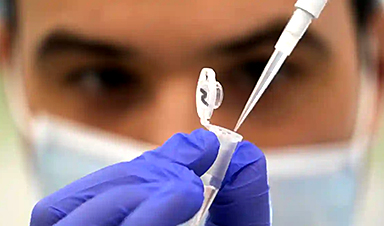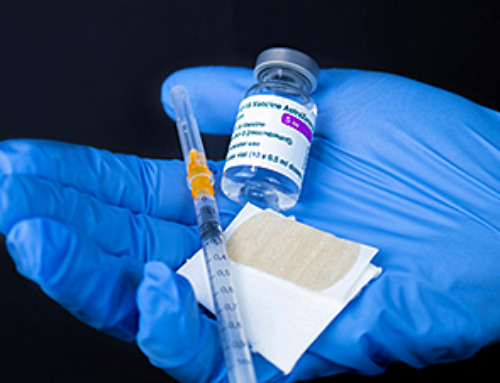British researchers are developing a groundbreaking technology to monitor genetic changes in respiratory viruses as they circulate round the world. The system is to be used to pinpoint dangerous new variants as they emerge and act as an early warning system for new diseases and future pandemics.
The team, which is based at the Wellcome Sanger Institute in Cambridgeshire, intends to make the technology cheap, easy to use and capable of being scaled up to provide global surveillance of a wide range of viruses. Targets would include influenza viruses, respiratory syncytial virus (RSV), coronaviruses and previously unknown pathogens.
The ultimate aim of the project – the Respiratory Virus and Microbiome Initiative – is to create a system that would deploy DNA sequencing technology to identify all viral, bacterial and fungal species in a single sample collected from a nose swab from a patient.
“The knowledge and data we generated allowed us to track – with unprecedented speed and accuracy – Sars-CoV-2, the virus responsible for Covid-19, and to monitor how it was changing. It was a wonderful aid in helping to fight the disease. Now we are aiming to contribute building a global genomic surveillance for all respiratory viruses. These, after all, are the agents most likely to trigger new pandemics,” Harrison added.
An illustration of the threat of future pandemics is provided by coronaviruses. Three times in the past 20 years, a previously unknown coronavirus emerged to infect humans: Sars in China and neighbouring countries; Mers in the Middle East; and Covid-19, which affected the whole planet.
However, it was the use of genomic surveys during the Covid pandemic that revealed the technology’s remarkable potential. In December 2020, when there was a sudden rise in Covid cases in south-east England, the technology showed that this surge had been triggered by the appearance of a new, more infectious variant. Known originally as the Kent strain, it was later relabelled the Sars-CoV-2 Alpha variant.
“The discovery was a gamechanger,” said John Sillitoe, leader of the Sanger Institute’s genomic surveillance unit. “We generated genomic data very quickly and could see that this variant was transmitting at a very high rate. Suddenly, the world could see what genomics could do. It allows you to see changes in viruses much, much more quickly than by other methods, and now we are going to exploit that power.”
The Sanger team is collaborating with the UK Health Security Agency, British academics, and other public health bodies on the project, with the aim of developing techniques that will allow them to sequence – from a single sample – not just one virus variant but any that might be infecting a patient. Typically, samples would be taken from individuals newly admitted to a hospital, where signs of a new, emerging disease are likely to first appear.
However, such technology would have to be adaptable to laboratories around the world. “It would be no good if the UK and one or two other developed countries learned how to sequence respiratory virus genomes and no one else,” added Sillitoe. “If we don’t have this kind of surveillance globally, we’re not going to spot a dangerous new variant until it has already spread over much of the planet.”
For the system to work across the globe, it would have to be the easiest, cheapest, fastest and most amenable to scaling that could be designed, said Sillitoe. “In many labs around the world, people have smaller sequencing machines and cannot sequence as many samples as we can at the Sanger. So we want the system to work equally well on those machines as it does here on our large volume devices.”
Harrison told the Observer that three different versions of the technology were now being tested. “Over the coming months, we will be seeing if we can swap bits and possibly come up with a hybrid in the end. The aim would be to get a usable system in operation in a year, although there will always be room for improvements after that,” he added.
“The crucial point is that we have got to develop a system that uses inexpensive reagents, does not require teams of highly-trained technicians and can be used at scale. Then we can really make a difference.
“At present, for many respiratory viruses, we have sequenced maybe 1,000-2,000 of their genomes. We want to create hundreds of thousands of genomes for each of them in the near future. The information they will provide will be priceless, not just in tracking a new disease but in speeding up vaccine and drug development.”
The team at the Sanger Institute is not the only group of scientists working on expanding genomic surveys to cover many other emerging viruses. Centres in the US and in Germany are also working on similar projects.
News
Scientists Unlock a New Way to Hear the Brain’s Hidden Language
Scientists can finally hear the brain’s quietest messages—unlocking the hidden code behind how neurons think, decide, and remember. Scientists have created a new protein that can capture the incoming chemical signals received by brain [...]
Does being infected or vaccinated first influence COVID-19 immunity?
A new study analyzing the immune response to COVID-19 in a Catalan cohort of health workers sheds light on an important question: does it matter whether a person was first infected or first vaccinated? [...]
We May Never Know if AI Is Conscious, Says Cambridge Philosopher
As claims about conscious AI grow louder, a Cambridge philosopher argues that we lack the evidence to know whether machines can truly be conscious, let alone morally significant. A philosopher at the University of [...]
AI Helped Scientists Stop a Virus With One Tiny Change
Using AI, researchers identified one tiny molecular interaction that viruses need to infect cells. Disrupting it stopped the virus before infection could begin. Washington State University scientists have uncovered a method to interfere with a key [...]
Deadly Hospital Fungus May Finally Have a Weakness
A deadly, drug-resistant hospital fungus may finally have a weakness—and scientists think they’ve found it. Researchers have identified a genetic process that could open the door to new treatments for a dangerous fungal infection [...]
Fever-Proof Bird Flu Variant Could Fuel the Next Pandemic
Bird flu viruses present a significant risk to humans because they can continue replicating at temperatures higher than a typical fever. Fever is one of the body’s main tools for slowing or stopping viral [...]
What could the future of nanoscience look like?
Society has a lot to thank for nanoscience. From improved health monitoring to reducing the size of electronics, scientists’ ability to delve deeper and better understand chemistry at the nanoscale has opened up numerous [...]
Scientists Melt Cancer’s Hidden “Power Hubs” and Stop Tumor Growth
Researchers discovered that in a rare kidney cancer, RNA builds droplet-like hubs that act as growth control centers inside tumor cells. By engineering a molecular switch to dissolve these hubs, they were able to halt cancer [...]
Platelet-inspired nanoparticles could improve treatment of inflammatory diseases
Scientists have developed platelet-inspired nanoparticles that deliver anti-inflammatory drugs directly to brain-computer interface implants, doubling their effectiveness. Scientists have found a way to improve the performance of brain-computer interface (BCI) electrodes by delivering anti-inflammatory drugs directly [...]
After 150 years, a new chapter in cancer therapy is finally beginning
For decades, researchers have been looking for ways to destroy cancer cells in a targeted manner without further weakening the body. But for many patients whose immune system is severely impaired by chemotherapy or radiation, [...]
Older chemical libraries show promise for fighting resistant strains of COVID-19 virus
SARS‑CoV‑2, the virus that causes COVID-19, continues to mutate, with some newer strains becoming less responsive to current antiviral treatments like Paxlovid. Now, University of California San Diego scientists and an international team of [...]
Lower doses of immunotherapy for skin cancer give better results, study suggests
According to a new study, lower doses of approved immunotherapy for malignant melanoma can give better results against tumors, while reducing side effects. This is reported by researchers at Karolinska Institutet in the Journal of the National [...]
Researchers highlight five pathways through which microplastics can harm the brain
Microplastics could be fueling neurodegenerative diseases like Alzheimer's and Parkinson's, with a new study highlighting five ways microplastics can trigger inflammation and damage in the brain. More than 57 million people live with dementia, [...]
Tiny Metal Nanodots Obliterate Cancer Cells While Largely Sparing Healthy Tissue
Scientists have developed tiny metal-oxide particles that push cancer cells past their stress limits while sparing healthy tissue. An international team led by RMIT University has developed tiny particles called nanodots, crafted from a metallic compound, [...]
Gold Nanoclusters Could Supercharge Quantum Computers
Researchers found that gold “super atoms” can behave like the atoms in top-tier quantum systems—only far easier to scale. These tiny clusters can be customized at the molecular level, offering a powerful, tunable foundation [...]
A single shot of HPV vaccine may be enough to fight cervical cancer, study finds
WASHINGTON -- A single HPV vaccination appears just as effective as two doses at preventing the viral infection that causes cervical cancer, researchers reported Wednesday. HPV, or human papillomavirus, is very common and spread [...]





















